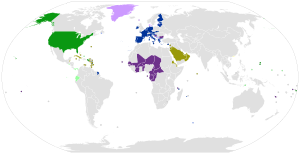
The dollar is also used as the standard unit of currency in international markets for commodities such as gold and petroleum (the latter sometimes called petrocurrency is the source of the term petrodollar). Some non-U.S. companies dealing in globalized markets, such as Airbus, list their prices in dollars.
The U.S. dollar is the world's foremost reserve currency. In addition to holdings by central banks and other institutions, there are many private holdings, which are believed[by whom?] to be mostly in one-hundred-dollar banknotes (indeed, most American banknotes actually are held outside the United States). All holdings of U.S.-dollar bank deposits held by non-residents of the United States are known as "eurodollars" (not to be confused with the euro), regardless of the location of the bank holding the deposit (which may be inside or outside the U.S.).
Economist Paul Samuelson and others (including, at his death, Milton Friedman) have maintained that the overseas demand for dollars allows the United States to maintain persistent trade deficits without causing the value of the currency to depreciate or the flow of trade to readjust. But Samuelson stated in 2005 that at some uncertain future period these pressures would precipitate a run against the U.S. dollar with serious global financial consequences.[56]


No comments:
Post a Comment